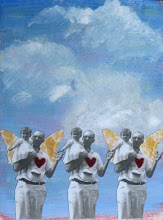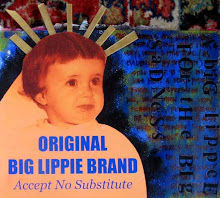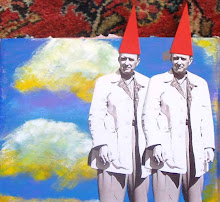 I’m in love with Vincent Van Gogh and I have been for as long as I can remember (in spite of my not having chosen him as my “Dead Soul Mate” here a few years back). Sometimes my feelings are in full-blown obsession, sometimes in merciful remission. Right now, I’m feeling it big time, baby. While I like Vincent’s work (I’m more partial to his lesser known graphite, chalk, pen and ink drawings than his Impressionist canvases, and among his paintings his self portraits over his landscapes), I personally am more enamored of the man himself. While the majority of people dismiss him as a madman, albeit a genius lunatic, there was so much more to him than the manic loony who lopped off an ear.
I’m in love with Vincent Van Gogh and I have been for as long as I can remember (in spite of my not having chosen him as my “Dead Soul Mate” here a few years back). Sometimes my feelings are in full-blown obsession, sometimes in merciful remission. Right now, I’m feeling it big time, baby. While I like Vincent’s work (I’m more partial to his lesser known graphite, chalk, pen and ink drawings than his Impressionist canvases, and among his paintings his self portraits over his landscapes), I personally am more enamored of the man himself. While the majority of people dismiss him as a madman, albeit a genius lunatic, there was so much more to him than the manic loony who lopped off an ear.
Vincent was an exceptionally intelligent, extraordinarily well-read person who spoke multiple languages and loved to hold in-depth discussions with people, in spite of the fact that most people routinely (and sadly) avoided any conversation with him at all. He felt acutely the pain and suffering of humanity, which was the cause of much of his troubles. He desperately wanted to connect with people, but was instead misunderstood and ostracized because he was so different from everyone else, even from those within the contemporary artist communities of his day. His loneliness and solitude were never a conscious choice, but rather a miserable condition forced upon him by society in general, and which only exacerbated his neuroses. His desperation and pain are palpable, even 119 years after his death.
I’m presently reading four books on Vincent all at once, cross-referencing as I work my way through them all: Lust for Life, the epic biographical novel from 1934 by Irving Stone, Van Gogh Face to Face: The Portraits, by the Detroit Institute of Arts which is the companion book to a 2000 exhibition of his portraits as well as a comprehensive volume of his portraiture in various media, I, Van Gogh by Isabel Kuhl, and my personal favorite which I’m re-reading yet again: The Yellow House: Van Gogh, Gauguin and Nine Turbulent Weeks in Arles by Martin Gayford. I adore this last book.
While all artists tend to be colorful and somewhat odd people, Vincent in his individuality, his sensitivity and his manic and frequently intensely strange behavior makes all the others seem rather dull and boring by comparison. He saw poetry in the ordinary and the commonplace, and beauty in that which is most ugly. He knew that true beauty is found in suffering and in the depths of the soul and not in the superficial or the 'safe'. He knew that that which is the most flawed is also the most transcendent, much like Vincent himself was.
I couldn’t imagine life without Van Gogh in it. What a boring place it would be had he never graced this world with his magical presence. Thank you Vincent.
Vincent Van Gogh, Sien Seated, May 1882, graphite, ink and sepia
 I've finally finished this drawing of Bram. It's actually almost life-size, which isn't saying much since he weighs all of four pounds. I'm fairly pleased with it for a change, although each time I look at it I can easily see what I should have done differently and what's not quite "right." Believe it or not, given my penchant for drawing my dogs, I have no other sketches of either one in the works right now. Instead I'm working on two self portraits and a pastel of a room in my house. I think I've done the dog thing to death at this point, but that said, I'm sure I'll be back drawing one or the other of them again soon. It's an addiction of sorts. I've been asked countless times why I draw them so much and do I ever draw anything else? And the answer to those two questions are "because I like to draw them" and "yes, loads of other things, in addition to all the paintings that you'll never see here online." If Monet can paint dozens of paintings of the Cathedral at Rouen or haystacks or his lily pond over and over and over again, then why can't I draw the same two dogs over and over again? I hate being defensive about my art, but I also hate feeling as though I am being forced to defend my art.
I've finally finished this drawing of Bram. It's actually almost life-size, which isn't saying much since he weighs all of four pounds. I'm fairly pleased with it for a change, although each time I look at it I can easily see what I should have done differently and what's not quite "right." Believe it or not, given my penchant for drawing my dogs, I have no other sketches of either one in the works right now. Instead I'm working on two self portraits and a pastel of a room in my house. I think I've done the dog thing to death at this point, but that said, I'm sure I'll be back drawing one or the other of them again soon. It's an addiction of sorts. I've been asked countless times why I draw them so much and do I ever draw anything else? And the answer to those two questions are "because I like to draw them" and "yes, loads of other things, in addition to all the paintings that you'll never see here online." If Monet can paint dozens of paintings of the Cathedral at Rouen or haystacks or his lily pond over and over and over again, then why can't I draw the same two dogs over and over again? I hate being defensive about my art, but I also hate feeling as though I am being forced to defend my art. 







